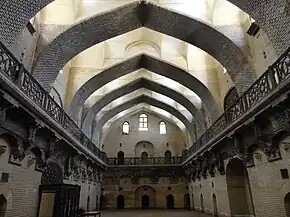33°20′19″N 44°23′33″E / 33.3386°N 44.3925°E
| Khan Murjan | |
|---|---|
| Native name خان مرجان | |
 | |
| Location | 89QR+CXM, Baghdad, Iraq |
| Built | 1356-1358 |
| Built for | Merchants needing a Khan |
| Restored | Mid-1980s |
| Architectural style(s) | Baghdadi Architecture |
The Khan Murjan (Arabic: خان مرجان, also: Khan Marjan) is a building in the souk of Baghdad, Iraq built by Aminuddin Murjan. The structure was first built in the 14th century as a caravanserai, an inn for traveling merchants, whose center was a hall more than 13 metres (43 ft) high.[1] The crenelated arches of brick and perforated windows make this a notable piece of architecture.
The building was reputedly in a state of disrepair for over two centuries, with waist-high flood water from the Tigris standing in the famous hallway. By the mid-1980s, the building had been restored and was in use as a restaurant.[1][2]
History
The Khan Murjan was built between 1356 and 1358. The khan is distinguished from other khans, another term for caravanserai, by its architecture: its inner courtyard is covered by huge arches of bricks, with a ceiling height of 13 metres. The khan has two floors: the ground floor contains 22 rooms, and the upper floor contains 23 rooms.[3] The outside is decorated with Islamic calligraphy. [4] The building is associated with Amin al-Din Murjan, who had also built the Murjan Mosque, which is located on al-Rasheed Street. The main function of the khan is to shelter merchants, their caravans, their goods, and the animals carrying the goods. It also remains one of the rare khans whose plan did not include an open central courtyard, as is the case with the designs of most other khans. [5]
In 1937, a Museum of Arab Antiquities was opened in the former Khan Murjan building.[6] This museum was dedicated to Islamic artifacts in a show of Arab nationalism by the Director of Antiquities, Sati' al-Husri.[7] By the mid-1980s, under the leadership of Saddam Hussein, the building was turned into a tourist restaurant in which it materialized an authentic Baghdadi atmosphere with Iraqi Maqam being played inside. Waiters could be found in traditional clothing with guests singing at their tables. Additionally, Maqam artists such as Yousef Omar have been invited to play.[3]
Present
Today, the Khan Murjan is among the oldest of the remaining khans in Iraq and is operated by Liwan for Culture and Development and the State Board of Antiquities and Heritage (SBAH).[8] Its restoration is being led by the International Alliance for the Protection of Heritage in Conflict Areas.[8]
The influence of the Khan Murjan is apparent beyond Baghdad. In Dubai, United Arab Emirates, the Khan Murjan Souk at WAFI Mall is a popular tourist destination. The mall spectacle has four quarters that are set in a 14th-century souk with decorations and architecture influenced by historic Egypt, Syria, Morocco, and Turkey.[9] The WAFI Mall also hosts the Khan Murjan Restaurant, where people can have breakfast, lunch, and dinner.[10]
In Tampa, Florida, a restaurant called the Khan Murjan served traditional Iraqi and Halal food. The restaurant was closed as of November 2023.[11]
Gallery


 Khan Murjan cafe
Khan Murjan cafe Interior
Interior
References
- 1 2 Scherping, Jan (2002). Unbekannter Irak. National Geographic De. p. 219. ISBN 9783934385870. Retrieved 15 September 2012.
- ↑ Docherty, J. P. (1988). Iraq. Chelsea House. ISBN 9780791000946. Retrieved 15 September 2012.
- 1 2 "يا مثقفي بغداد ... أنقذوا خان مرجان - ديوان العرب". diwanalarab.com. Retrieved 2023-08-03.
- ↑ "Caravanserai in Baghdad | Dialogue Across Borders". www.dialogueacrossborders.com. Retrieved 2023-10-22.
- ↑ "قراءة ثانية لعمارة: خان مرجان : بهو بغداد المترف". almadapaper.net. Retrieved 2023-08-03.
- ↑ Bernhardsson, M.T. 2005. Reclaiming a Plundered Past, Archaeology and Nation Building in Modern Iraq. Austin, TX, USA: University of Texas Press.
- ↑ "A Guide To The Arab Museum At Khan Marjan In Baghdad. - DIRECTORATE-GENERAL OF ANTIQUITIES". www.maggs.com. Retrieved 2023-10-22.
- 1 2 "Khan Marjan: A Cultural Icon of Baghdad | Aliph Foundation - Protecting heritage to build peace". Aliph Foundation. Retrieved 2023-11-27.
- ↑ "Khan Murjan Souk - Traditional Arabian Souk". WAFI City. Retrieved 2023-11-27.
- ↑ "Khan Murjan Restaurant - Genuine Arabic Taste". Retrieved 2023-11-27.
- ↑ "Khan Murjan is a Middle Eastern Restaurant in Tampa, FL 33617". tampairaqifood.com. Retrieved 2023-11-27.
Sources
- Babaie, Sussan (2019). Iran After the Mongols. Bloomsbury Publishing. ISBN 978-1788315289.